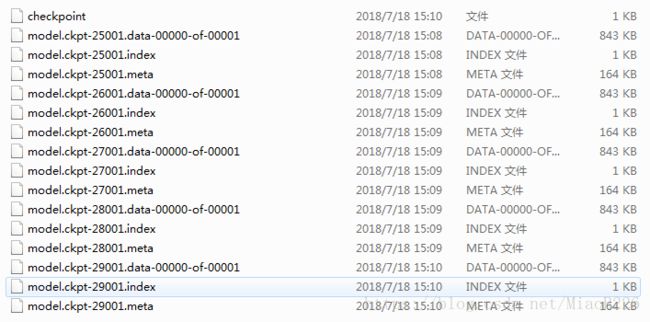TensorFlow从入门到放弃(一)——实现经典神经网络模型LeNet5
1.mnist手写数字数据集
下载地址:http://yann.lecun.com/exdb/mnist/
2. LeNet5网络模型
第一层:卷积层
这一层的输入就是原始的图像像素32*32*1。第一个卷积层过滤器尺寸为5*5,深度为6,偏置亦为6,不使用全0填充,长和宽的步长为1。所以这一层的输出:28*28*6,卷积层共有5*5*1*6+6=156个参数。
第二层:池化层
这一层的输入为第一层的输出,是一个28*28*6的节点矩阵。本层采用的过滤器大小为2*2,长和宽的步长均为2,所以本层的输出矩阵大小为14*14*6。
第三层:卷积层
本层的输入矩阵大小为14*14*6,使用的过滤器大小为5*5,深度为16,偏置为16。本层不使用全0填充,长和宽的步长为1。本层的输出矩阵大小为10*10*16。本层有5*5*6*16+16=2416个参数。
第四层:池化层
本层的输入矩阵大小10*10*16。本层采用的过滤器大小为2*2,长和宽的步长均为2,所以本层的输出矩阵大小为5*5*16。
第五层:全连接层
本层的输入矩阵大小为5*5*16,在LeNet-5论文中将这一层称为卷积层,但是因为过滤器的大小就是5*5,所以和全连接层没有区别。如果将5*5*16矩阵中的节点拉成一个向量,那么这一层和全连接层就一样了。本层的输出节点个数为120,总共有5*5*16*120+120=48120个参数。
第六层:全连接层
本层的输入节点个数为120个,输出节点个数为84个,偏置亦为84,总共参数为120*84+84=10164个。
第七层:全连接层
本层的输入节点个数为84个,输出节点个数为10个,偏置亦为10,总共参数为84*10+10=850。
3.使用TensorFlow实现LeNet5神经网络
3.1 初学TensorFlow的个人理解:
一个完整的TensorFlow实现的网络模型需要包换三个文件:
- Inference.py,这个文件定义了网络的前向传播过程以及神经网络中的参数初始化。
- train.py,这个文件定义了神经网络的训练过程。文件中包含了损失函数的定义、学习率的定义、滑动平均操作以及训练过程、以及将训练得到的model的存储。
- eval.py,这个文件定义了测试过程。用训练得到的model重现网络。
3.2 mnist_inference.py中的常用函数:
函数一
![]()
name:名称
shape:数据的维度
tf.constant_initializer(0.0):初始化全为0的常量
tf.truncated_normal_initializer(stddev=0.1)):初始化产生一个正态分布的初始值,标准差为0.1。
函数二
实现relu激活函数
input:输入
biases:偏置
函数三
将数据加上偏置
函数四
实现卷积层的前向。
实现最大池化。
input[batch_size, length , width, channels]:本层的输入
weights:本层的权重
strides=[1,1,1,1]:1和4位置上的必须是1,2和3位置上的是长和宽的步长。
Padding:’SAME’全0填充,’VALID’不填充
函数五
创建命名空间
函数六
![]()
将权重规格化后加到loss中
函数七
实现全连接层的前向运行
函数八
tf.nn.dropout(fc1, 0.5)这里的0.5是保存的概率,不是遗忘的概率
3.3 mnist_inference.py
import tensorflow as tf
# 输入和输出数据的维度
# 手写数字数据集的图像特征是一个1*784的特征向量
INPUT_NODE = 784
OUT_NODE = 10
# 图像的尺寸、通道数和标签个数
IMAGE_SIZE = 28
NUM_CHANNELS = 1
NUM_LABELS = 10
# 第一卷积层的尺寸和深度
CONV1_DEEP = 6
CONV1_SIZE = 5
# 第二卷积层的尺寸和深度
CONV2_DEEP = 16
CONV2_SIZE = 5
# 全连接层的节点个数
FC1_SIZE = 120
FC2_SIZE = 84
# 定义卷积神经网络的前向传播过程。这里添加了一个新的参数train,用于区别训练过程和测试过程。
# 在这个程序中将用到dropout方法
# dropout可以进一步提升模型可靠性并防止过拟合(dropout过程只在训练时使用)
def inference(input_tensor, train, regularizer):
with tf.variable_scope('layer1-conv1'):
conv1_weights = tf.get_variable("weight", [CONV1_SIZE, CONV1_SIZE, NUM_CHANNELS, CONV1_DEEP],
initializer=tf.truncated_normal_initializer(stddev=0.1))
conv1_biases = tf.get_variable("bias", [CONV1_DEEP],initializer=tf.constant_initializer(0.0))
conv1 = tf.nn.conv2d(input_tensor, conv1_weights, strides=[1,1,1,1], padding='SAME')
relu1 = tf.nn.relu(tf.nn.bias_add(conv1, conv1_biases))
with tf.variable_scope('layer2-pool1'):
pool1 = tf.nn.max_pool(relu1, ksize=[1,2,2,1], strides=[1,2,2,1], padding='VALID')
with tf.variable_scope('layer3-conv2'):
conv2_weights = tf.get_variable("weight", [CONV2_SIZE, CONV2_SIZE, CONV1_DEEP, CONV2_DEEP],
initializer=tf.truncated_normal_initializer(stddev=0.1))
conv2_biases = tf.get_variable("bias", [CONV2_DEEP],
initializer=tf.constant_initializer(0.0))
conv2 = tf.nn.conv2d(pool1, conv2_weights, strides=[1,1,1,1], padding='SAME')
relu2 = tf.nn.relu(tf.nn.bias_add(conv2, conv2_biases))
with tf.variable_scope('layer4-pool2'):
pool2 = tf.nn.max_pool(relu2,ksize=[1,2,2,1],strides=[1,2,2,1], padding='VALID')
# 用于将每张图片数据拉成一个一维的向量
# pool_shape[0]-batch_size,pool_shape[1]、pool_shape[2]-图的长和宽,pool_shape[3]-channel
pool_shape = pool2.get_shape().as_list()
nodes = pool_shape[1] * pool_shape[2] * pool_shape[3]
reshaped = tf.reshape(pool2,[pool_shape[0], nodes])
with tf.variable_scope("layer5-fc1"):
fc1_weights = tf.get_variable("weight", [nodes,FC1_SIZE],
initializer=tf.truncated_normal_initializer(stddev=0.1))
if regularizer != None:
tf.add_to_collection("losses", regularizer(fc1_weights))
fc1_biases = tf.get_variable("bias", [FC1_SIZE], initializer=tf.constant_initializer(0.1))
fc1 = tf.nn.relu(tf.matmul(reshaped, fc1_weights)+fc1_biases)
# LRN层,实现侧抑制,遗忘一半
if train:
fc1 = tf.nn.dropout(fc1, 0.5)
with tf.variable_scope("layer6-fc2"):
fc2_weights = tf.get_variable("weight",[FC1_SIZE,FC2_SIZE],
initializer=tf.truncated_normal_initializer(stddev=0.1))
# 个人理解这个规格化的目的是为了求loss值,并未影响到网络里面的值感觉在测试阶段
# 这个regularizer可以不用
if regularizer != None:
tf.add_to_collection("losses", regularizer(fc2_weights))
fc2_biases = tf.get_variable("bias",[FC2_SIZE], initializer=tf.constant_initializer(0.1))
fc2 = tf.nn.relu(tf.matmul(fc1, fc2_weights)+fc2_biases)
if train:
fc2 = tf.nn.dropout(fc2,0.5)
with tf.variable_scope("layer7-fc3"):
# 最后一层的数据不需要采用relu激活函数
fc3_weights = tf.get_variable("weight",[FC2_SIZE, NUM_LABELS],
initializer=tf.truncated_normal_initializer(stddev=0.1))
if regularizer != None:
tf.add_to_collection("losses", regularizer(fc3_weights))
fc3_biases = tf.get_variable("bias", [NUM_LABELS], initializer=tf.constant_initializer(0.1))
logit = tf.matmul(fc2,fc3_weights)+fc3_biases
return logit
3.4 mnist_train.py
import os
import numpy as np
import tensorflow as tf
from tensorflow.examples.tutorials.mnist import input_data
import mnist_inference
# 每次取多少张图片训练
BATCH_SIZE = 100
# 基础学习率
LEARNING_RATE_BASE = 0.01
# 学习率下降梯度
LEARNING_RATE_DECAY = 0.99
# L2规则化的系数
REGULARIZATION_RATE = 0.0001
# 训练次数
TRAINING_STEPS = 30000
# 计算滑动平均的系数
MOVING_AVERAGE_DECAY = 0.99
# 定义训练得到模型保存的路径和文件名
MODEL_SAVE_PATH = 'E:\\PythonSpace\\LeNet5\\model'
MODEL_NAME = 'model.ckpt'
def train(mnist):
# 定义网络的输入数据维度和标签数据维度
x = tf.placeholder(tf.float32, [BATCH_SIZE, mnist_inference.IMAGE_SIZE, mnist_inference.IMAGE_SIZE,
mnist_inference.NUM_CHANNELS], name='x-input')
y_ = tf.placeholder(tf.float32,[None, mnist_inference.OUT_NODE], name='y-input')
# 定义L2规格化
regularizer = tf.contrib.layers.l2_regularizer(REGULARIZATION_RATE)
# 调用前向函数实现训练网络的前向运行
y = mnist_inference.inference(x, True, regularizer)
# 定义训练轮数,并将这个变量设为不训练
global_step = tf.Variable(0, trainable=False)
# 初始化滑动平均类
variable_averages = tf.train.ExponentialMovingAverage(MOVING_AVERAGE_DECAY, global_step)
# 对所有需要训练的变量使用滑动平均
variable_averages_op = variable_averages.apply(tf.trainable_variables())
# 计算交叉熵损失函数,并求均值
cross_entropy = tf.nn.sparse_softmax_cross_entropy_with_logits(logits=y, labels=tf.argmax(y_,1))
cross_entropy_mean = tf.reduce_mean(cross_entropy)
# loss = 交叉熵损失值的均值 + L2规则化的weight
loss = cross_entropy_mean + tf.add_n(tf.get_collection('losses'))
# 定义学习率更新方法
# 每训练mnist.train.num_examples/BATCH_SIZE次,修改学习率为LEARNING_RATE_BASE*LEARNING_RATE_DECAY
learning_rate = tf.train.exponential_decay(LEARNING_RATE_BASE, global_step, mnist.train.num_examples/BATCH_SIZE, LEARNING_RATE_DECAY)
# 用来优化损失函数
train_step = tf.train.GradientDescentOptimizer(learning_rate).minimize(loss, global_step=global_step)
# 这句话的作用是更新权重和偏置的系数,以及更新参数的平均值
with tf.control_dependencies([train_step, variable_averages_op]):
train_op = tf.no_op(name='train')
# 这个saver用于实现数据持久化
saver = tf.train.Saver()
with tf.Session() as sess:
# 初始化所有变量
tf.global_variables_initializer().run()
for i in range(TRAINING_STEPS):
# 读取数据集图像信息和标签
xs, ys = mnist.train.next_batch(BATCH_SIZE)
# 将784维的特征转换为28*28
reshaped_xs = np.reshape(xs, (BATCH_SIZE, mnist_inference.IMAGE_SIZE, mnist_inference.IMAGE_SIZE,
mnist_inference.NUM_CHANNELS))
# 开始训练
_, loss_value, step = sess.run([train_op, loss, global_step],feed_dict={x:reshaped_xs, y_:ys})
# 每训练1000次将model保存
if i % 1000 == 0:
print("After %d training step(s), loss on training"
"batch is %g. " %(step, loss_value))
saver.save(sess, os.path.join(MODEL_SAVE_PATH, MODEL_NAME), global_step=global_step)
# 定义主函数
def main(argv=None):
# 读取mnist数据集数据
mnist = input_data.read_data_sets(r"E:\PythonSpace\mnist_data\\", one_hot=True)
train(mnist)
if __name__=='__main__':
tf.app.run()3.5 代码运行截图
存储的模型文件
3.6 mnist_eval.py
import time
import numpy as np
import tensorflow as tf
from tensorflow.examples.tutorials.mnist import input_data
import mnist_inference
import mnist_train
# 每10秒加载一次模型
EVAL_INTERVAL_SECS = 10
def evaluate(mnist):
with tf.Graph().as_default() as g:
# 定义输入数据的维度和格式
x = tf.placeholder(tf.float32, [mnist.validation.num_examples, mnist_inference.IMAGE_SIZE,
mnist_inference.IMAGE_SIZE, mnist_inference.NUM_CHANNELS],
name='x-input')
y_ = tf.placeholder(tf.float32,[None, mnist_inference.OUT_NODE], name='y-input')
# 提取验证集的图片和标签,并将图片转换为28*28的
xs = mnist.validation.images
reshaped_xs = np.reshape(xs, (mnist.validation.num_examples, mnist_inference.IMAGE_SIZE,
mnist_inference.IMAGE_SIZE, mnist_inference.NUM_CHANNELS))
validate_feed = {x:reshaped_xs, y_:mnist.validation.labels}
# 测试的时候不用计算正则化损失函数,而且不用调用遗忘函数
y = mnist_inference.inference(x, 0, None)
# 计算准确率并减均值
correct_prediction = tf.equal(tf.argmax(y,1),tf.argmax(y_,1))
accuracy = tf.reduce_mean(tf.cast(correct_prediction, tf.float32))
# 调用训练的滑动平均值
variable_averages = tf.train.ExponentialMovingAverage(mnist_train.MOVING_AVERAGE_DECAY)
variables_to_restore = variable_averages.variables_to_restore()
saver = tf.train.Saver(variables_to_restore)
while True:
with tf.Session() as sess:
# 读取保存的最新的模型文件
ckpt = tf.train.get_checkpoint_state(mnist_train.MODEL_SAVE_PATH)
if ckpt and ckpt.model_checkpoint_path:
print(ckpt.model_checkpoint_path)
# 利用模型还原网络
saver.restore(sess, ckpt.model_checkpoint_path)
global_step = ckpt.model_checkpoint_path.split('\\')[-1].split('-')[-1]
# 计算准确率
accuracy_score = sess.run(accuracy, feed_dict=validate_feed)
print("After %s training step(s), validation "
"accuracy = %g" %(global_step, accuracy_score))
else:
print ('No checkpoint file found')
return
time.sleep(EVAL_INTERVAL_SECS)
def main(argv=None):
mnist = input_data.read_data_sets(r"E:\PythonSpace\mnist_data\\", one_hot=True)
evaluate(mnist)
if __name__ == '__main__':
tf.app.run()3.7 运行结果
以上是自己初次学习TensorFlow的一个小例子,一些理解有可能存在错误,欢迎批评指正。





